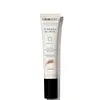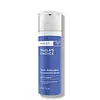What's inside
What's inside
 Key Ingredients
Key Ingredients

 Benefits
Benefits

 Concerns
Concerns

No concerns
 Ingredients Side-by-side
Ingredients Side-by-side

Titanium Dioxide 2.1%
Cosmetic ColorantZinc Oxide 17%
Cosmetic ColorantDimethicone
EmollientCaprylic/Capric Triglyceride
MaskingDimethicone Crosspolymer
Emulsion StabilisingDimethicone/Vinyl Dimethicone Crosspolymer
Skin ConditioningButyloctyl Salicylate
Skin ConditioningGlyceryl Isostearate
EmollientPolysilicone-15
UV FilterNiacinamide
SmoothingCaffeine
Skin ConditioningUbiquinone
AntioxidantTetrahexyldecyl Ascorbate
AntioxidantTocopheryl Acetate
AntioxidantSqualane
EmollientPunica Granatum Extract
AstringentVaccinium Macrocarpon Fruit Extract
AstringentCamellia Sinensis Leaf Extract
AntimicrobialSilica
AbrasivePEG/PPG-18/18 Dimethicone
EmulsifyingPolyhydroxystearic Acid
EmulsifyingTriethoxycaprylylsilane
Iron Oxides
Titanium Dioxide 2.1%, Zinc Oxide 17%, Dimethicone, Caprylic/Capric Triglyceride, Dimethicone Crosspolymer, Dimethicone/Vinyl Dimethicone Crosspolymer, Butyloctyl Salicylate, Glyceryl Isostearate, Polysilicone-15, Niacinamide, Caffeine, Ubiquinone, Tetrahexyldecyl Ascorbate, Tocopheryl Acetate, Squalane, Punica Granatum Extract, Vaccinium Macrocarpon Fruit Extract, Camellia Sinensis Leaf Extract, Silica, PEG/PPG-18/18 Dimethicone, Polyhydroxystearic Acid, Triethoxycaprylylsilane, Iron Oxides
Cyclopentasiloxane
EmollientDimethicone
EmollientTetrahexyldecyl Ascorbate
AntioxidantPalmitoyl Tripeptide-5
Skin ConditioningCeramide NP
Skin ConditioningTocotrienols
Skin ConditioningTocopherol
AntioxidantUbiquinone
AntioxidantThioctic Acid
AntioxidantTocopheryl Acetate
AntioxidantMagnesium Ascorbyl Phosphate
AntioxidantFerulic Acid
AntimicrobialBeta-Glucan
Skin ConditioningSuperoxide Dismutase
AntioxidantEpigallocatechin Gallate
AntioxidantErgothioneine
AntioxidantGlutathione
Xanthophylls
Skin ConditioningGlycine Soja Seed Extract
Skin ConditioningGlycerin
HumectantArctostaphylos Uva Ursi Leaf Extract
Skin ConditioningLupinus Albus Seed Extract
Skin ConditioningCurcuma Longa Root
Skin ConditioningElaeis Guineensis Oil
EmollientPhenoxyethanol
PreservativeCyclopentasiloxane, Dimethicone, Tetrahexyldecyl Ascorbate, Palmitoyl Tripeptide-5, Ceramide NP, Tocotrienols, Tocopherol, Ubiquinone, Thioctic Acid, Tocopheryl Acetate, Magnesium Ascorbyl Phosphate, Ferulic Acid, Beta-Glucan, Superoxide Dismutase, Epigallocatechin Gallate, Ergothioneine, Glutathione, Xanthophylls, Glycine Soja Seed Extract, Glycerin, Arctostaphylos Uva Ursi Leaf Extract, Lupinus Albus Seed Extract, Curcuma Longa Root, Elaeis Guineensis Oil, Phenoxyethanol
 Reviews
Reviews

Ingredients Explained
These ingredients are found in both products.
Ingredients higher up in an ingredient list are typically present in a larger amount.
Dimethicone is a type of synthetic silicone created from natural materials such as quartz.
What it does:
Dimethicone comes in different viscosities:
Depending on the viscosity, dimethicone has different properties.
Ingredients lists don't always show which type is used, so we recommend reaching out to the brand if you have questions about the viscosity.
This ingredient is unlikely to cause irritation because it does not get absorbed into skin. However, people with silicone allergies should be careful about using this ingredient.
Note: Dimethicone may contribute to pilling. This is because it is not oil or water soluble, so pilling may occur when layered with products. When mixed with heavy oils in a formula, the outcome is also quite greasy.
Learn more about DimethiconeTetrahexyldecyl Ascorbate (THD) is a stable and oil-soluble form of Vitamin C.
THD is special in that it has the ability to travel deeper into skin than traditional ascorbic acid while maintaining the same skin benefits (double win!).
Because it’s oil-soluble, THD dives deep into your skin’s fatty layers (think ceramides and cholesterol) to fight off the kind of free radicals that mess with your skin barrier. This makes it a great pair with water-based vitamin C (ascorbic acid) that mainly works on the surface.
Even at just 0.1%, THD is already showing great antioxidant activity. When used up to 2%, it helps keep your skin happy and calm, especially when it’s stressed from pollution or sun.
Want to fade dark spots or tackle hyperpigmentation? You’ll want 5% or more. Pairing it with brightening buddies like niacinamide or licorice root gives even better results. One study even used 30% THD with other brighteners and saw real results on stubborn discoloration, even in melasma-prone skin.
A note on THD: It’s has a slightly silky, oily texture and usually shows up colorless or pale yellow (though the exact shade can vary by supplier).
While you can sneak it into water-based formulas, it really shines when paired with silicones or oils, which help your skin soak it up better.
THD is pretty stable, but it’s still vulnerable to degradation like ascorbic acid. Too much light or heat (above 113°F / 45°C) can break it down over time. Go for dark and opaque packaging that keeps it safe and shady!
Read more about other types of Vitamin C:
Learn more about Tetrahexyldecyl AscorbateTocopheryl Acetate is AKA Vitamin E. It is an antioxidant and protects your skin from free radicals. Free radicals damage the skin by breaking down collagen.
One study found using Tocopheryl Acetate with Vitamin C decreased the number of sunburned cells.
Tocopheryl Acetate is commonly found in both skincare and dietary supplements.
Learn more about Tocopheryl AcetateUbiquinone (Coenzyme Q10) is a molecule already found in our bodies. It is a potent antioxidant and skin-soothing ingredient.
Aging and environmental exposure diminishes our skin's natural ubiquinone levels. This is much like our natural collagen and elastin.
The good news is: studies show applying this ingredient topically replenishes ubiquinone levels in our skin. This also comes with a ton of skin benefits. These benefits include:
Ubiquinone is considered a large molecule and cannot be absorbed into the lower layers of skin. This is why it is believed to be such an effective antioxidant: it protects our skin in the upper layers and prevents damage in the deeper layers.
When used in sunscreen, ubiquinone is shown to increase ingredient stability, increase SPF factor, and add to infrared protection.
Fun fact: ubiquinone is fat-soluble.
Learn more about Ubiquinone